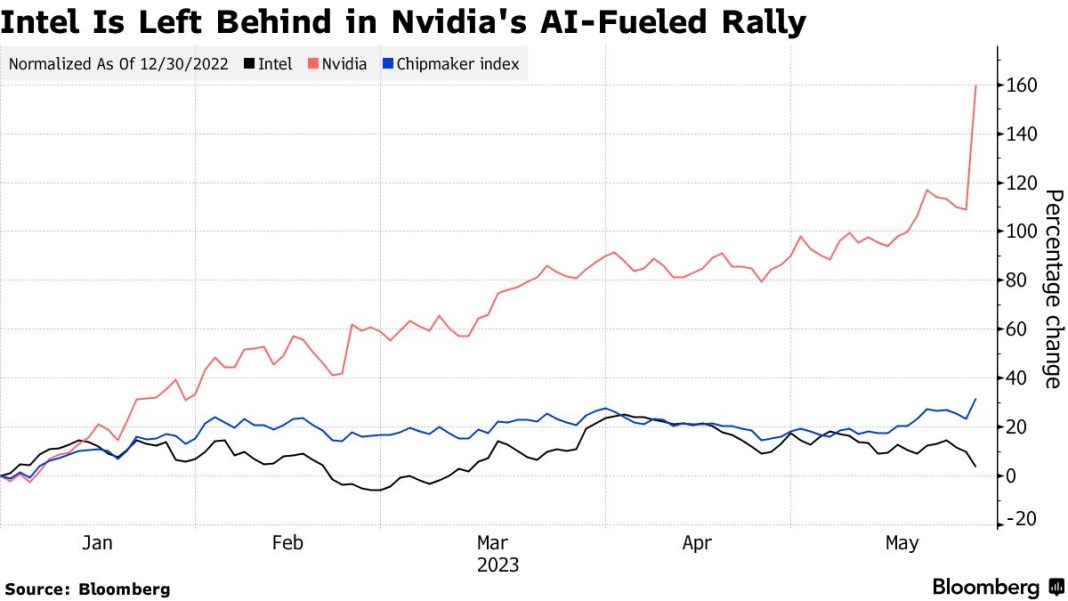The enthusiasm surrounding artificial intelligence (AI) ever since the debut of ChatGPT in November 2022 is still in full swing, rapidly engulfing various industries. This relentless wave of innovation is reshaping the technological landscape, with tech giants racing to develop cutting-edge generative AI models to meet escalating demands.
Among the beneficiaries of this AI boom, the semiconductor industry finds itself in an enviable spot, poised to capitalize on the surging need for AI chips capable of powering generative AI models. With the AI revolution continuing to gain momentum, chip giant Intel Corporation (INTC) is strategically positioning itself to harness this wave of transformation.
Despite most of last year’s AI frenzy being indebted to NVIDIA Corporation (NVDA), thanks to its GPUs powering prominent AI models, such as ChatGPT, INTC is determined not to lag behind either.
Last year, INTC introduced Gaudi3, an AI chip tailored for generative AI software. Expected to debut this year, Gaudi3 will join the competition against NVDA’s H100, a popular option for companies constructing extensive chip farms to drive AI applications, and Advanced Micro Devices, Inc.’s (AMD) upcoming MI300X, slated to begin shipping to customers in 2024.
In addition to Gaudi3, INTC unveiled Core Ultra chips tailored for Windows laptops and PCs alongside new fifth-generation Xeon server chips. Notably, both chip variants feature a dedicated AI component known as an NPU, enhancing the capability to execute AI programs more swiftly.
This strategic move also serves as a signal to investors regarding the potential for increased demand for their chips in the AI-driven landscape.
Furthermore, in a recent move, INTC unveiled a range of new platforms, solutions, and services encompassing network and edge AI, Intel® Core™ Ultra processors, the AI PC, and beyond. This initiative aims to enhance total cost of ownership (TCO) and operational efficiency while ushering in fresh innovations and services.
In this modern era, where staying competitive necessitates embracing technological advancements, INTC is rolling out products and solutions to enable its customers, partners, and vast ecosystems to seize the emerging opportunities presented by AI and integrated automation.
With the demand for chips that fuel generative AI models soaring all across the globe, industry giants like INTC, AMD, and NVDA are engaging in fierce competition to deliver cutting-edge AI chips, surpassing escalating performance expectations.
However, the ambitious expansion plans of these major chip giants met with hurdles last year in October when the Biden administration implemented measures to restrict the types of semiconductors that American companies can sell to China.
U.S. Commerce Secretary Gina Raimondo emphasized the administration’s commitment to safeguarding national security by limiting access to critical technologies, rigorously enforcing regulations, and minimizing unintended impacts on trade flows.
Nevertheless, INTC bypassed export restrictions by supplying chips worth hundreds of millions of dollars to the heavily sanctioned Chinese tech and telecom companies in Huawei. This move, which allowed INTC to furnish Huawei with chips for laptop use, has sparked criticism from its competitor, AMD.
INTC’s chip sales to Huawei notably surged between 2020 and 2023, while AMD’s sales witnessed a decline.
This discrepancy arose from the United States Department of Commerce granting special permissions to select American suppliers of Huawei, including INTC, to sell specific items to the company in 2020. However, AMD’s efforts to secure a license to sell similar chips under President Joe Biden’s administration went unanswered.
On the other hand, despite bypassing restrictions to sell chips to Huawei, INTC experienced a decline in overall sales in China in 2023 due to the export ban. China holds significant importance for INTC, with revenue from billings to the country constituting 27% of its total sales.
Last year, INTC generated a total of $14.85 billion of its revenue in China, marking a year-over-year decline of more than 13%.
Meanwhile, both AMD and NVDA witnessed a notable decline in sales to China, surpassing that of INTC as a result of the stringent export control regulations imposed by the U.S. government.
Moreover, there is a growing likelihood that INTC could encounter comparable restrictions to those faced by AMD and NVDA. This stems from mounting pressure on President Biden to revoke the license granted by the Trump administration, permitting INTC to continue chip supplies to Huawei.
Bottom Line
With shares roughly up more than 50% over the past year, INTC has successfully capitalized on the AI tailwinds. Despite challenges, including export restrictions and intensifying competition, INTC remains committed to innovation and expansion in the AI chip market.
According to Gartner, Intel holds the top position as the largest semiconductor maker by revenue in 2023 despite having a market cap that ranks below NVDA and AMD. The company’s fourth-quarter results witnessed a 9.7% year-over-year rise in its topline figure, reaching $15.41 billion. Its net income stood at $2.67 billion versus a net loss of $664 million in the prior year’s quarter.
Pat Gelsinger, CEO of INTC, remarked that the company achieved robust fourth-quarter results, surpassing expectations for the fourth consecutive quarter, with revenue reaching the higher end of their guidance.
Furthermore, he emphasized INTC’s commitment to advancing its mission of making AI technology accessible across various sectors while generating long-term value for stakeholders.
The stock also appears quite reasonably priced compared to its industry peers. For instance, INTC’s non-GAAP price-to-earnings (P/E) ratio of 31.21x is lower than NVDA’s 35.62x and AMD’s 52.36x, respectively.
However, despite its commendable efforts and dedication to capture the global AI chip market, there is an increasing possibility that INTC may encounter similar restrictions as those faced by AMD and NVDA.
This adds uncertainty to Intel’s prospects, particularly as its competitor NVDA plans to initiate mass production of a downgraded version of its AI chips specifically designed for China in the second quarter of 2024 to comply with U.S. export regulations.
In conclusion, while INTC has made significant strides in the AI chip sector and boasts solid fundamentals, the looming regulatory challenges pose a risk to its growth trajectory. Therefore, investors could carefully monitor the stock for now and wait for a better entry point.


